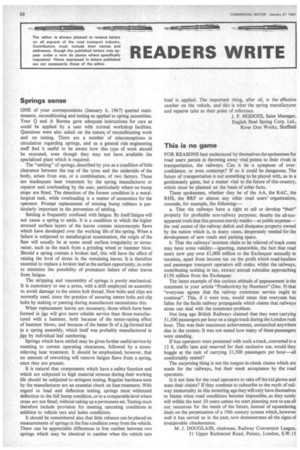This is no game
Page 60

If you've noticed an error in this article please click here to report it so we can fix it.
FOR REASONS best understood by themselves the spokesmen for road users persist in throwing away vital points to their rivals in transportation, the railways. Can it be a symptom of overconfidence, or even contempt? If so it could be dangerous. The future of transportation is not something to be played with, as in a gentlemanly game, but a matter vital to the future of this country, which must be planned on the basis of sober facts.
These spokesmen, whether they be of the AA, the RAC, the RHS, the BRF or almost any other road users' organization, concede, for example, the following:— a. That the railways have a right to sell or develop "their" property for profitable non-railway purposes; despite the all-tooapparent truth that this process merely masks—at public expense— the real extent of the railway deficit and dissipates property owned by the nation which is, in many cases, desperately needed for the development of new roads and parking space.
b. That the railways' insistent claim to be relieved of track costs may have some validity—ignoring, meanwhile, the fact that road users now pay over £1,000 million to the Exchequer annually in taxation, apart from income tax on the profit which road hauliers and passenger transport operators still make; whilst the railways, contributing nothing in tax, extract annual subsidies approaching £150 million from the Exchequer.
The latest example of this curious attitude of appeasement is the statement in your article "Productivity by Numbers" (Dec. 9) that "everyone agrees that the railway commuter service ought to continue". This, if it were true, would mean that everyone has fallen for the facile railway propaganda which claims that railways alone can deal with the commuter problem.
Not long ago British Railways claimed that they were carrying 31,500 passengers per hour on a single track during the London rush hour. This was their maximum achievement, unmatched anywhere else in the system. It was not stated how many of these passengers were standing.
If bus operators were presented with such a track, converted to a 12 ft. traffic lane and reserved for their exclusive use, would they boggle at the task of carrying 31,500 passengers per hour—all comfortably seated?
The surprising thing is not the tongue-in-check claims which are made for the railways, but their meek acceptance by the road operators.
Is it not time for the road operators to take off the kid gloves and state their claims? If they continue to subscribe to the myth of railway immortality in this motoring age they will only have themselves to blame when road conditions become impossible, as they surely will within the next 10 years unless we start planning now to use all our resources for the needs of the future, instead of squandering them on the perpetuation of a 19th century system which, however well it has served us in the past, now demonstrates all the signs of irrenjevable obsolescence.
M. J. DOUGLASS, chairman, Railway Conversion League, 51 Upper Richmond Road, Putney, London, S.W.15












































































































